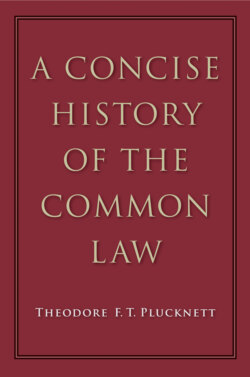Читать книгу A Concise History of the Common Law - Theodore F. T. Plucknett - Страница 26
На сайте Литреса книга снята с продажи.
THE GREAT CHARTER
ОглавлениеThis is a long document of sixty chapters and represents the extreme form of the baronial demands. The next ten years saw the progressive shortening of the Charter by omitting much that was temporary, by putting the important clauses concerning the forests into a separate document (called the Charter of the Forest), and by pruning the excesses of the victorious barons. John obtained a bull from his new over-lord, the Pope, annulling the charter.1 Indeed, some of its provisions were much too extreme, particularly the last, which erected a commission of twenty-five barons with power to enforce the Charter by coercing the King. The Great Charter of 1215 was therefore actually law for only about nine weeks. The King died shortly after (1216).
The council who ruled in the name of the infant Henry III re-issued the charter in 1216 (this time with papal assent) very much modified in favour of the Crown, with a promise to re-open the question when the French invasion, undertaken at the will of the rebel barons, had been defeated. This promise they fulfilled in 1217 on the occasion of the treaty whereby Prince Louis withdrew, and this, the third, Great Charter contains “numerous, important, and minute” changes whose general tendency was again in favour of the Crown. It was felt that the boy King ought not to suffer for his father’s sins, and that the difficult period of a minority was no time to weaken the central government; in any case, it was a committee of nobles who actually ruled in Henry’s name and any limitation on his power would only make their task of governing the harder. Hence the successive compromises of 1216 and 1217. At length, in 1225, Henry III came of age and issued the fourth Great Charter which differed from the third in slight details only. This is the document which is still law (except in so far as it has been repealed) and is cited by the old authors as the charter or statute of the ninth year of Henry III. It was not enrolled until many years later when, in 1297, it was put on the statute roll (word for word, except one slight slip), and so is also sometimes cited as the statute Confirmatio Cartarum of 25 Edward I.2 On numerous later occasions during the middle ages it was solemnly confirmed and from that day to this has been held in the deepest respect both in England and in America. After all these revisions Magna Carta as it now stands on the statute books of common law jurisdictions is a sober, practical, and highly technical document. A complete understanding of all its provisions would require a whole volume upon numerous aspects of mediaeval law and administration; for our present purpose the following summary will suffice.3
